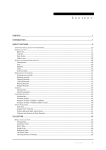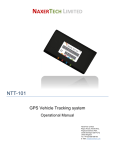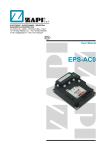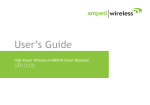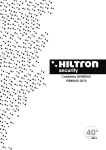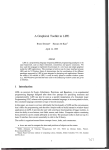Download TVXM44
Transcript
User Manual INDEX 1 Package.................................................................................................................4 2 Introduction ..........................................................................................................4 3 Architecture of system ........................................................................................5 4 Functional features ..............................................................................................6 4.1 General..............................................................................................................6 4.2 Alarm system.....................................................................................................7 5 Technical features................................................................................................8 6 System to fixed net ..............................................................................................9 6.1 Introduction........................................................................................................9 7 Installation ..........................................................................................................10 7.1 Hardware.........................................................................................................10 7.2 Warning ...........................................................................................................11 7.3 Power supply...................................................................................................11 7.4 Description of connectors ................................................................................12 7.4.1 20 pole terminal block (J21):.......................................................................13 7.4.2 Terminal 6 poles (J9): .................................................................................13 7.5 Outputs feasible burlaps..................................................................................14 7.6 LED .................................................................................................................16 7.6.1 Fixed net.....................................................................................................16 7.6.2 Attivity: ........................................................................................................16 7.6.3 GPRS: ........................................................................................................16 7.7 Choosing video cameras.................................................................................17 7.8 Connecting video cameras ..............................................................................17 7.9 Ethernet network .............................................................................................17 7.10 GPRS network.................................................................................................17 7.11 Anti-theft zone .................................................................................................18 7.12 Reset...............................................................................................................18 7.13 Procedure of password rescue........................................................................18 7.14 Configuration of GPRS connection..................................................................19 7.14.1 Type of GPRS connection ..........................................................................19 7.14.2 Type of SIM ................................................................................................19 7.14.3 Procedure of recording and connect...........................................................20 7.15 Control unit configuration.................................................................................21 7.15.1 Systema menù:...........................................................................................21 7.15.2 Mobile menù ...............................................................................................23 7.15.3 Record menù ..............................................................................................25 7.15.4 Video menù ................................................................................................27 7.15.5 Alarms menù ..............................................................................................28 7.15.6 Motion Menù...............................................................................................34 7.15.7 Setting grill survey movement and privacy .................................................35 7.15.8 Scheduler menù .........................................................................................36 7.15.9 Menù events ...............................................................................................37 7.15.10 Menù other.htm......................................................................................37 8 Web interface......................................................................................................40 8.1 Home page......................................................................................................40 8.2 Command buttons ...........................................................................................40 8.3 Image adjustement..........................................................................................41 2 8.4 Viewing and sending commands from a WAP mobile phone ..........................42 8.4.1 Visualization and commandos in User modality .........................................42 8.4.2 Visualization and commands in Administrator modality..............................44 8.4.3 Visualization and commando from PDA ....................................................45 9 Visualization recorded image............................................................................46 9.1 Visualization recorded image in central unit memory .....................................46 3 1 Package • • • TVXM44 1 GPRS antenna 3 Fischer by 8 mm 2 Introduction TVXM44 is a system that allows you to control from anywhere and extremely simply: your home or your business, and your possessions, while at the same time enhancing you and your family’s personal security; a second home, without having to visit the actual location to check for damage or intrusions. The system can be managed directly or through a Security Company. TVXM44 combines two different types of equipment: a web server that controls between 1 and 4 analogue video cameras (black and white and/or colour) and transfers images, either directly or in response to an external inquiry, over a fixed (ADSL) and/or mobile (GPRS) network; • A burlar alarm that controls four wired zones. The TVXM44 device is a digital video surveillance system that stores and transfers JPEG images and MPEG4 film recordings, from 4 analogue video cameras , through: • a fixed network with an ADSL connection • a mobile network with a GPRS connection The system can be required to remotely send a video stream or send it automatically in response to an alarm to preset addresses. In addition, the device incorporates all the functions of a traditional alarm control centre (4 cabled zones + anti-sabotage zone + burglar alarm). A If an alarm is set off (motion detected in the view monitored by the video cameras or traditional alarms), the system can announce it by sending an e-mail, SMS message or DTMF tones (making a normal telephone call in real time!); E-mail alarm notifications have the photograph (JPEG format) relating to the event that generated the alarm attached, while an SMS including the URL (address of the site) where you can see the image that generated the alarm. Users can access the images acquired in real time and can configure the operational parameters for the control centre by using any PC or smartphone with a standard browser connected to the Internet, from anywhere in the world and without the need for any proprietary software. 4 3 Architecture of system The diagram below shows the architecture of the digital video surveillance system TVXM44: The TVXM44 control units convert the analogue video signal from the video cameras into high quality digital images. These images that are then transmitted over a fixed (ADSL) and/or GPRS network to the Service Centre (if the system is used by security companies) or to users that have permission to view them. control units convert the analogue video signal from the video cameras into high quality digital images. These images that are then transmitted over a fixed (ADSL) and/or GPRS network to the Service Centre (if the system is used by security companies) or to users that have permission to view them.. Using a common browser from a remote device, the user can access the images acquired by the four video cameras in real time and configure the parameters for the operation of the control unit. 5 4 Functional features 4.1 • • • • • • • • • • • • • • • • 6 General Image display in JPEG format from 4 video inputs individually or simultaneously (QUAD) Image display in MPEG4 format (the appropriate plug-in must be installed on the computer where you want to view the MPEG4 images) of the plug in on CD of installation on site FTP of CIA Group); Adjustment of brightness, contrast, quality and saturation Definition of “privacy zones” when displaying images (parts of the grid are obscured) Recording and storage of roughly 1000 photographs (quality=4) Recording of images h24 on a ftp server of on a net disc (Samba), in local o remote; Management to define a time of prealarm (from 15 sec to 2 min) and of post alarm (from 30 sec to 1 hour) for the recording activated from alarm condition; Management of User Password (required for displaying images); Management of Administrator Password (required for full management of the TVXM44 system) Management of mobile phone Password (access in WAP modality); Management of the device name Management of telephone numbers for remote management Management of Alarm Servers (for installations managed by Security Companies) Management of Dynamic DNS; Software updating available via Internet connection 4.2 • • • • • • • • • • • • • • • • • • • • • • • • • • Alarm system A 24-hour anti-sabotage protection zone Four protection zones programmable in delayed and immediate modes (normally open/normally closed), individually excludable; Detection of movement inside a framed area generating an alarm (Motion Detection); Ready for connection to command systems: proximity key, electronic key, electronic keypad and magnetic card Operation in Burglar Alarm mode; Alarms (or Warning) in response to system faults and/or tampering, with the possibility of sending e-mail and/or SMS and/or DTMF tones: No 230 Vac power supply; no ADSL connection or a cut in Ethernet cable; absence router, absence rete ADSL; absence Snat Server; no GSM network coverage; no GPRS network coverage; video cameras obscured (no video signal) Control unit tampering alarm (tamper protection against removal and opening of the control unit housing) FTP Server unreachable warning with possibility of sending email and/or SMS Cycles of adjustable alarms (1 - 2- 4 -8 -16 - infinites); Entrance time adjustable from 0 to 3 minutes; Exit time adjustable from 5 seconds to 3 minutes Alarm duration adjustable from 3 to 10 minutes (can be deactivated remotely) Availability of relay exchange of alarms (maximum 5) Maximum output 12 V – 1A to power indoor sirens Output for self-powered sirens Backup battery that allows the system to remain operational for roughly 8 hours (video cameras not powered by the TVXM44 system). Sending of alarm notification email with JPEG photograph attached. It is possible to send alarm notification emails to multiple recipients Sending of alarm notification SMS with URL attached. It is possible to send alarm notification SMS messages to multiple recipients 7 5 Technical features Rated supply voltage Maximum absorption Video inputs Input Ethernet LAN Video resolution Image resolution Video media file format GSM Rated service output voltage Maximum current supplied for service output Maximum current supplied for siren output Fuse on primary transformer Siren output fuse Service power output fuse Backup sealed lead battery Operating temperature Dimensions (W) Dimensions (H) Dimensions (D) 230 Vac 50 Hz 250 mA 4 10 Base-T 352*288 pixel Da 88*72 a 740*576 (JPEG) Jpeg e Mpeg4 Tri band EGSM900, GSM 1800, GSM 1900 12.5 Volt ± 5%. 1A 1 A (IMPORTANT: the sum of the maximum current supplied from the service output and the siren output cannot exceed 1.3A) 1 A – 250 V type F (5*20 glass) 1 A 250 V type F – rapid 1 A 250 V type F – rapid 12V 7Ah (not encluded) 10° ÷ 60° C 244 mm 285 mm 73 mm The product is supplied of a loyal antenna GPRS with the container. Product TVXM44 satisfies previewed essential requirement from "European Directive R&TTE 99/05/CE” and is in compliance with normative following: CEI EN 55022 (1995): norms on electromagnetic interferences CEI EN 55024 (1999): norms on electromagnetic immunity CEI EN 60950-1 (2001-12): norms on the emergency of the products 8 6 System to fixed net 6.1 Introduction Normal Flat ADSL subscriptions use the technique of dynamic addressing. This means that the IP address of the system (equivalent to telephone number of a subscriber) changes over time. When the systems operate in this mode, it is not possible to reach a device connected to the system from any point on the Internet network. Users of the TVXM44 device can solve this problem in two ways: Ask your Internet Provider for a set-up with a static IP address (this solution normally has a higher subscription cost than solutions with a dynamic address); For to resolve this problem is used the technique of the Port Forwarding on Router. The impossibility to use such technique (for reasons of computer science emergency or because the router it is managed from Thirds party and the demands to carry out the Port Forwarding is satisfied) determines, for the Customer, the implication not to be able to interrogate the machine from remote. In such situation it will be able to receive the alarm information but not to only approach the images. For the users of apparatus TVXM44, it’s solvable in two ways simply since to the start the apparatus is recorded free of charge to dynamic service DNS on SNAT "seriexm.it" and SNAT "seriexm.com". It will be possible, recording the apparatus with the name, as an example, “Casa Rossi” to catch up it with: "casarossi.seriexm.it" or (casarossi.seriexm.com). 9 7 Installation 7.1 10 Hardware 7.2 Warning 7.3 Power supply Do not install the control unit in places exposed to extremes of temperature or to bad weather.For reliable wall mounting of the unit, you must make sure that the surface of the wall is smooth.Attach the control unit at a height that allows easy access to the front panel. The control unit is itself protected against tampering, and installing it in a protected location and possibly in the coverage zone of a volumetric detector provides a further. The connections to the terminal blocks must be carried out, after the unit has been mounted, in accordance with the CEI 79-3 standard “Specific regulations for anti-burglary, anti-intrusion, anti-theft and anti-aggression systems.” The 230 Vda mains voltage must be connected to the power supply / battery recharger (terminals indicated as 230 V in photograph no. 2) with a double insulated cable coming from an isolating switch (for example, a magneto thermic switch) used exclusively for the anti-theft control unit. Inside the TVXM44 device, position the leads in a sufficiently ordered manner, blocking them with clamps. Once the installation is finished, connect the two leads that have cable ties (faston type) from the power supply to the battery. Pay careful attention to the connection polarity: • Red = battery positive • Black = battery negative Attention: the appropriate clip indicated in the photo must always be carried out the logon to earth of the device using. In case of connection of users to 12 V of service to make attention very not to exceed the prefixed limits of absorption. Attention in this case is advised to active cargos (to make to activate the infrared of eventual television cameras fed burlaps) to measure the tension under cargo verifying that 12,0 V are not under i. In overload case the telephone exchange could not work correctly 11 7.4 Description of connectors Removing the cover you can access the connections of the main board: • • • • • • • 12 3 pole connector (J 15) 24h Connector (J12) BNC Connector (J20) BNC Connector (J19) RJ45 Connector BNC Connector (J17) BNC Connector (J16) Power supply for electronic boards 24H Video input N.1 Video input N.2 LAN Video input N.3 Video input N.4 7.4.1 20 pole terminal block (J21): SK - GND: for activating and deactivating the control centre: • contact closed = control centre activated; • contact open = control centre deactivated. +12 - GND: 12 V power supply for possible auxiliary devices: maximum current supplied 1 A (protected by fuse F1 of 1 A). NO – COM – NC: Free exchange of alarm relay (RLA - 5 A max) for the connection of signalling devices that cannot be connected directly to terminals 8 and 10. • At rest: NC connected with COM and NA free. • In alarm: NO connected with COM and NC free. SIR+ – GND: 12 V power supply for connecting indoor sirens; maximum current supplied 1 A (protected by fuse F2 of 1 A) • At rest: connector open; • in alarm: voltage 12V (on the terminal). SA+ – GND: Enabling 12V for self-powered sirens: • At rest: voltage (12V) on the terminal • in alarm: terminal no connected T24 – GND: 24h anti-sabotage line (immediate) Contact normally closed. The 24-hour line has anti-opening and anti-removal tamper protection inside the control unit and external devices for the entire system (connected in series) Z1 – Z2 – Z3 – Z4: Zones 1 programmable (normally opened, normally closed and timed); 7.4.2 Terminal 6 poles (J9): GND; TV1 – TV2 – TV3 – TV4 Output to 12Vdc: Attivabled / Deattivabled; GND. 13 7.5 Outputs feasible burlaps The outputs feasible burlaps TV1,TV2,TV3 and TV4 can to be programmable, individually, in more ways: • For camera: The output changes to +12V if the telephone exchange finds the presence of marks them video on the correspondent income video (TV1 - CAM1; TV2 - CAM2; TV3 - CAM3; TV4 - CAM4) • On alarm: The output changes to +12V (o a 0V) when an allarm is verified; • On activation: The output changes to +12 V (or 0V) when the control unit is activated; • Manual: The output changes to +12V on a command received for PC or , it’s opened a second window where it’s Telephone. Push the button possible to activate / deactivate the siren and the four output feasible burlaps. 14 The name of the output change by <12V On> to <12V Off> For to activate/deactivate the output from the smartphone, follow this two ways: • Sending a SMS from a burlap management number • Sending the appropriate commando from a cellular WAP On: deactivate: the output change to +12V (or to 0V) when the central unit is deactivated; Buzzer 1 / 2: Used for to connect a buzzer for to having confirmation of the enabling / disabling of the central unit. In this condition the telephone exchange generates 1 impulse (of duration and interval of generation) to the enabling and 2 impulses to the disabling. Buzzer 2 / 1: Used for to connect a buzzer for toh ave a confirmation of the enabling / disabling of the central unit. In this condition the central unit generates 2 impulses (of duration and programmable interval of generation) at the enabling and 1 impulse to disabling. State zones: The telephone exchange carries out the control of all and the 4 zones of alarm. The line predisposed for such control will go to + 12V if or more zones will turn out in one "be of alarm" (for Window protect from opened forgotten magnetic sensor). In all the conditions over listed the escape can be programmed in order to simulate a push-button, whose time of activation is programmable from 10 msec to 1 hour (to use, as an example, in order to open an gate at a distance). 15 7.6 LED On the main board are present three red led called: • Fixed net • Attivity • GPRS 7.6.1 Fixed net 7.6.2 Attivity: LED blinking 1 flashing / second 2 flashing / second 3 flashing / second LED LED blinking LED on 7.6.3 GPRS: LED blinking 1 flash / second 2 flash / second 3 flash / second LED on fixed 16 Absence of Ethernet Presence of Ethernet Presence of router Presence ADSL Connection to SNAT server absence of packages transmitted from the telephone exchange on the channel of e/mobile fixed net presence of packages transmitted on at least one of the transmission channels Absence of GSM signal Presence of GSM signal / Absence GPRS Presence GPRS Connection GPRS attived Connection to SNAT server 7.7 Choosing video cameras 7.8 Connecting video cameras 7.9 Ethernet network Particular attention must be paid to the choice of video cameras, which depends on the performance required from the video surveillance system. Fundamental parameters in making the right choice are: • the environmental conditions in which they will have to operate (internal locations or locations exposed to bad weather) • Lighting conditions of the scenes to be recorded • the size of the scene to be recorded and the distance of the video camera from it It is worth underlining that a further consideration for making the right choice is whether the system is used simply as a means of tele-surveillance or as apparatus for recognising movement and generating alarms. In the second case, in fact, if the location is not lit (for example, a closed repository during night-time hours) or the lighting of the surroundings is not sufficient (a parking space in an open location) you must decide whether to: • illuminate the site in a permanent way during the “obscuring” hours • use night & day video cameras if the lighting is sufficient • use infrared video cameras. Telecamera night&day con scarsa illuminazione stradale e telecamera da esterni con buona illuminazione stradale. Connect the leads of the video cameras to be connected to the connectors J20, J19, J17 and J16 (for video cameras 1,2,3 and 4 respectively) It is possible, if using 12 V video cameras, to take power for the video cameras from connector J21 pins 3 and 4. Connect the LAN connection cable (see paragraph 4 – Fixed network system) to the RJ45 connector (J18) 7.10 GPRS network Mount in the appropriate connector, positioned at the upper left-hand side of the container, the GPRS antenna contained in the package together (an 8 mm spanner is required to attach the antenna). With the system switched off, insert the SIM into the appropriate slot with the PIN disabled. 17 7.11 Anti-theft zone Connect the chosen devices for : • activation/deactivation; • wireline alarm sensor; • acoustic and / or light signals • buzzer for to confirmation of the enabling/disabling of the central unit. WARNING: If necessary, connect the power line for the video cameras (if the video cameras are powered via the TVXM44 control centre). 7.12 Reset Remote procedure: • type the following string into the address bar of the browser you are using: http://<namecentralunit>.seriexm.it/set?reboot=1 • press <enter> 7.13 Procedure of password rescue In the case the Administrator of system forgets the username and/or the Password for the access to the fortified telephone exchange to contact the technical attendance of the serial of central unit them. 18 7.14 Configuration of GPRS connection 7.14.1 Type of GPRS connection The system is provided with a GPRS module in order to allow connection to the internet via a mobile network. This connection can be programmed in the following ways: • Inactive: This type of connection is never used • Active: At the moment that it is switched on, the system establishes and keeps active a GPRS Internet connection in addition to the ADSL Internet connection. • Backup: At the moment that it is switched on, the system establishes a GPRS connection; after having verified the usability of the service, the system disconnects. Whenever the unavailability of the ADSL service is detected (for whatever reason), a connection to the network via the GPRS module is automatically re-established. • Backup on alarm: At the moment that it is switched on, the system establishes a GPRS connection; after having verified the usability of the service, the system disconnects. When an alarm condition is encountered, a connection to the network via the GPRS module is re-established. 7.14.2 Type of SIM Data-only GPRS SIM (usually called “machine to machine”) can only handle data traffic, but cannot make and/or receive voice calls. It must also be verified that the chosen Operator supports the sending and receiving of SMS messages for these SIM types. The use of a machine to machine SIM makes it impossible to use the following functions of the control centre: • Sending of DTMF tones in the case of alarms • Tele management of the machine by telephony 19 7.14.3 Procedure of recording and connect After switching on, a flashing light phase will start between the status LED and the LED named Active. After a few seconds, if the connection procedure has succeeded the LED called GPRS will light up (and remain on). If the SIM requires an APN other than the default and/or the username/password, these parameters must be configured to make the GPRS connection possible. If the apparatus is connected to a LAN, the configuration operation can be performed from configuration info menu.In the case of a connection that uses only a mobile network, an SMS message must be used: gprsApn=<name_APN> (for example: gprsApn=internet.wind.biz) or : gprsApn=<nameAPN>&gprsUser=<User>&gprsPwd=<password> (for example: gprsApn=uni.tim.it&gprsUser=3390102030405&gprsPwd=uccs) If the SMS configuration message is successful, the control unit sends an SMS notification message indicating the parameters that have been changed. 20 7.15 Control unit configuration You can configure the operational parameters of the control unit locally or remotely. Clicking on the symbol lets you access the configuration menus: 7.15.1 Systema menù: Parameter System Name Description Firmware Time and Date User Password Admin Password DHCP IP Address Netmasks Routers Servers DNS Public Access Point (ip:port) Description Name of the device. Insert the chosen name Insert the appropriate description If the device is normally connected to the Internet network, an online check is performed at the site www.seriexm.it to verify the edition of the software residing on the device. If the software of the device does not appear to be up to date, the user is given the option to download an update Date and time. If the system is connected to the Internet, the clock is automatically updated via the network You can insert the User Login name here. “User” means the person or persons enabled for viewing the images from the 4 TVXM44 video cameras. You can insert the User Password here. You can insert the Administrator Login name here. The Administrator is the person enabled for using (viewing the images on the 4 video cameras) and for modifying the configuration parameters for the operation of the TVXM44 video surveillance system. You can insert the Administrator Password here. Activate/deactivate the DHCP service Here you can insert the chosen IP Address for the apparatus 192.168.1.9 IP masks for the apparatus (default 255.255.255.0). The separator is a comma Here you can insert the IP Address of the router connected to the Internet IP Addresses of the IPM Group Server dedicated to dynamic DNS. Installation with Static IP: Insert the static IP Address followed by the number of the port used (example: 82.75.159.82:80). Installation with Dynamic IP (porta 80 o 8080 ):do not fill in the field. Installation with Dynamic IP (necessity to use another port); Insert the number of the port (for example 9000) 21 Snat Server Alarm Server Browser autentication Email sender Dinamic DNS Language Smtp Server Smtp user Smtp password The server CIA are pre loads snat.seriexm.it and snat.seriexm.com it dedicates to you to services D-DNS and SNAT This field is only filled in the case of a Centralised Surveillance Service (Security Company). In this case, the Static IP Address of the Centralised Service server must be inserted. DIGEST = authentication via login and password in encrypted mode BASIC = authentication with plaintext login and password. No mandatory : Inserire Insert the email address via which mail is to be sent. Else <utente>@mail.seriexm.it Insert the name that you want to use for registering the dynamic DNS to the CIA Server. After you have typed in the name, press the “salva” [save] button to perform the registration. Once the registration is complete, the machine will be reachable from any location by typing the following address: http://<user>.seriexm.it http://<user>.seriexm.com NOTE: If the name you choose has already been used (even by third parties), the Server will register the name, appending the mac of the apparatus NOTE: In the case of a GPRS connection, two names are registered: <user>.mobile.seriexm.it • <user>.mobile.seriexm.com It allows to select the language of the menus. In relation to the policy adopted from the Provider that is used for the logon to Internet of the apparatus could be necessary to qualify such menù and therefore to insert the name of the smtp of mail of the prechosen Provider let alone one login and one password of one email of the same one provider in order to make to work the apparatus correctly Insert the login related to the email boxl Insert the password related to email box Modifications and/or insertions will take effect only after you have pressed the button 22 7.15.2 Mobile menù Parameter IMEI PIN SIGNAL <Operator name> GPRS Timeout APN Description Visualizes the IMEI code of the GPRS module. Here you can insert the authentication code (PIN) of the SIM of the GSM/GPRS modem It gives the indication of the intensity of field of the GSM mobile network (da un simbolo + a cinque volte +). Affianco alla dizione Segnale comparirà il nome dell’Operatore di Rete Mobile. You can choose one of the following operating modes: INACTIVE In this mode, when the device is switched on, it establishes a GPRS connection; after verifying that the GPRS system is usable, it deactivates itself. BACKUP When the system is switched on, a GPRS connection is established. After verifying that the service is usable, the system disconnects. Whenever the unavailability of the ADSL service is detected (for whatever reason), a connection to the GPRS network is automatically re-established BACKUP ON ALARM When the system is switched on, a GPRS connection is established. After verifying that the service is usable, the system disconnects. Whenever any alarm condition is detected, a connection to the GPRS network is automatically re-established ACTIVE In this mode the device establishes a GPRS connection and keeps it always active. In case of “Backup on Alarm” it is possible to establish the time (machine will stay online 5 – 15 – 30 minuti) . If necessary, you must insert the APN of the chosen carrier. 23 Telemanage phone Redirect received Sms E-mail Temporized reading of credit Reading credit 24 the Enabled Telemanagement Numbers. Telephone numbers enabled for telemanagement of the alarm control unit. The sintax is <number1>;<number2>;<number3>… The telemanagement possibilities are the following: You can activate and deactivate the system remotely by sending an SMS message ( <ON> or <1> for activation; <OFF> or <0> for deactivation). You can tele-program 4 voltages (12 Vcc) on the J9 connector (see the description of the electric connections) by sending an SMS with the following text: <R=1> enable TV1 <R=01> enable TV2 <R=001> enable TV3 <R=0001> abilita TV4 <R=0> disable TV1 , TV2 , TV3 e TV4 <R=0111> disable TV1 <R=1011> disable TV2 <R=1101> disable TV3 <R=1110> disable TV4 Every time that the system is driven by sending an SMS, it replies to the numbers enabled for tele-management sending an SMS confirming that the operation has been performed. In the case of programmed telephone exchange with module GPRS in backup on alarm it is possible thanks to the number of telegestione of being able to activate the same one for being able to interrogate it from remote, carrying it on linens for approximately five minuteren with a simple call to the number of the brokerage house used (activation on ring) [ Such function allows to make to work the telephone exchange using the single mobile channel using for economic reasons one simple prepaid brokerage house If you choose the option <si> all the SMS sent to the SIM Card of the machine will be rebroadcasted toward the numbers of telegestione If you choose the option <si> in the field “lettura temporizzata del credito” the machine will send the reading of the residual credit in this field. It allows to establish the acdenza with which reading the residual credit of the used prepaid brokerage house The reading of relative the residual credit to inserted card prepaid brokerage house in the telephone exchange can be obtained (sees menù other.htm for the determination of the numbers which to connect itself in function of the Operator who has emitted the brokerage house) 7.15.3 Record menù Parameter Pre-allarm Post-alarm Frequency Record camera 1 Record camera 2 Record camera 3 Record camera 4 Network Resource User Resource Password Resource Free space Description Here you can insert the amount of images to be recorded before the alarm event If no FTP server has been configured (in the “Sistema” menu), the maximum quantity of pre-alarm images recorded is fixed at 2 minutes. Here you can insert the amount of images to be recorded after the alarm event If no FTP server has been configured (in the “Sistema” menu), the maximum quantity of post-alarm images recorded is fixed at 15 minutes. Select the frequency of recording on each camera There are two choices: • No: it not record the images of the camera 1 • Yes: it records the images of the camera 1 See above See above See above Insert the IP of the server (or of the disk used) for making the recording of the images. In the case of the ftp server the syntax is : ftp://<static_IP> In the case of the disk (samba) the syntax is: \\<name_disc>\<name_directory> in the disc case place in the same local net of the telephone exchange \\<IP_statico>\<name_directory> in the disc case place in one remote locality (in such case door 445 to the physical address of the disc must be opened) To insert the Name Customer for the access to serve ftp used for the recording To insert the Password for the access to server ftp used for the recording In the case of I use of a net disc (samba) indicates the free space on the disc 25 Recording Mode Duration interval • Only manual: The machine records the images after the activation botton of recording. • On movement: The machine records the images beginning from a motion (slow motion detector active). • It continues: modality 24h. The continuous recording is concurred single in the case of uses of a Ftp server or a disc of net In the case of continuous recording it can be chosen if to only record always or with the inserted apparatus The duration of the recording from an hour to a maximum of a month can be chosen Modifications and/or insertions will take effect only after you have pressed the button. 26 7.15.4 Video menù Parameter Speed Limit (Mb/s) Shading Grid Privacy Disabled Risolution for telephone Camera 1,2,3,4 Description 1,2,3,4 Camera Quality 1,2,3,4 Brightness 1,2,3,4 Saturation 1,2,3,4 Contrast 1,2,3,4 Description Select the maximum bandwidth to use for video transmission Obscuring for Privacy. If this parameter is set to “SI” (yes), it is possible to obscure zones for privacy, by using the “Griglia” (grid) button and defining the square in blue. • No: if the device is set to NO, images cannot be viewed or recorded when the system is inactive; • Yes: if the device is set to SI, images can be viewed or recorded when the system is inactive It’s possible to optimize the dimension of the screen ones received by the cellular phone; They are possible three dimensions: • Small 176 x 144 • Normal 352 x 288 • Big 704x576 The television cameras effectively connected to the telephone exchange (present must be defined). If program absent from the main shielded one is not possible to activate the vision on the correspondent television camera number It’s possibile to insert a description for the four cameras. Image quality (0-8 with default 4); low quality values increase the fluidity of movement while decreasing quality. Brightness of images (0-8 with default 4) Saturation of color (0-8 with default 4) Contrast of images (0-8 with default 4) Modifications and/or insertions will take effect only after you have pressed the button 27 7.15.5 Alarms menù Parameter Alarm cycles Delay in Exit Delay in Input Delay on warnings Siren on alarm Siren on antirob Siren Timeout Zone 1,2,3,4 Description 28 Description The cycles of alarm (1-2-4-8-16 or infinites) In the case can be programmed that to the term of the timeout of sirena programmed the telephone exchange it finds to last of the alarm condition on the zone that has generated provvederà to exclude it such zone. The zone will come only restored if the telephone exchange finds a return in the conditions not alarm Here you can insert the delay of the zones for entrance ( 0 sec.÷ 3min). Here you can insert the delay of the zones for the exit ( 0 sec.÷ 3min). (differing therefore I forward it of email, SMS, tones and performance of the devices sonorous and/or optical you) Interval of old time which it comes managed permanere of the absence of the programmed parameters (tamper, Absence 230V, Ethernet Absence, absence GSM, Logon GPRS, Absence router, Absence ADSL, Absence snat, Absence disc). Such interval is programmabile from 0 to 1 hour By default this parameter is set = SI [YES]. If you do not want the siren to be activated in an alarm condition, you must set this parameter to NO. It is possible to define if in the case of activation of the function it antirobs to make to play or less the siren Siren operation time after an alarm, adjustable from 3 to 10 minutes For each zone it is possible to define the status In this field relative description to the zone is possible to insert one (income, stay, warehouse, etc) At retired Delayed Antirobs Tamper 230 V absence It is possible to program, for every single zone, the type of contact R-retired (normally closed or opened) It is possible to program, for every single zone, the delayed modality or less (insertion that is of the time of delay in income and escape) Zone 4 can work also from zone antirobs. If active this modality of operation, such zone is active also when system TVXM44 is disinserito (insertion possibility push-button it antirobs) (you see menù other.htm for the message possibilities). The telephone exchange has two sensors (Tamper) that they can give indications on the opening of the cover and the removal of the same one from the wall. Such switches are in series to the line antimanomission. Following are possible chosen : • Not inform: The central unit exchange does not manage the events over mentions to you • Delayed warning: The central unit it manages the events over mentions to you if at least one of these lasts more in order of the prefixed interval • Inform: The central unit manages as warning the events over mentions to you immediately • Alarm: The central unit manages as alarm the events over mentions to you In warning case can be sendes email and SMS to you to two various and/or equal lists of destinatati to those relati you to the warning and/or alarm conditions The central unit exchange notices of the absence of the feeding to 230V. Following are possible chosen • It does not inform :The central unit exchange does not manage the events over mentions to you • Delayed warning :The central unit exchange manages the events over mentions to you if at least one of these lasts more in order of the prefixed interval. • Avvisa: La centralina gestisce come avviso gli eventi sopra menzionati immediatamente • Alarm: The central unit exchange manages as alarm the events over mentions to you In warning case can be sendes to you and mail and SMS to two various and/or equal lists of destinatati to those relati you to the warning and/or alarm conditions. 29 Ethernet absence GSM absence GPRS connection 30 The central unit exchange notices of the cut or the disconnection of cable RJ45 for the connection to net LAN. Following are possible chosen: It does not inform: • Not inform: The central unit exchange does not manage the events over mentions to you • Delayed warning: The central unit exchange manages the events over mentions to you if at least one of these lasts more in order of the prefixed interval • Informs: The central unit exchange manages as warning the events over mentions to you immediately • Alarm: The telephone exchange manages as alarm the events over mentions to you In warning case can be sendes to you and mail and SMS to two various and/or equal lists of destinatati to those relati you to the warning and/or alarm conditions. The telephone exchange notices of the absence of marks them GSM. Following are possible chosen: • Not inform: The central unit exchange does not manage the events over mentions to you • Delayed warning: exchange manages the events over mentions to you if at least one of these lasts more in order of the prefixed interval. • Informs: The central unit exchange manages as warning the events over mentions to you immediately • Alarm: the central unit exchange manages as alarm the events over mentions to you In warning case can be sendes to you and mail and SMS (this last one after the restoration of the Net) to two various and/or equal lists of destinatati to those relati you to the warning and/or alarm conditions. The central unit exchange notices of the absence of logon to net GPRS. Following are possible chosen: • Not inform: The central unit exchange does not manage the events over mentions to you • Delayed warning: The central unit exchange manages the events over mentions to you if at least one of these lasts more in order of the prefixed interval • Inform: The telephone exchange manages as warning the events over mentions to you immediately • Alarm: The central unit exchange manages as alarm the events over mentions to you In warning case can be sendes to you and mail and SMS to two various and/or equal lists of destinatati to those relati you to the warning and/or alarm conditions. Router absence ADSL absence Snat absence The central unit exchange notices of not corrected operation of the router. Following are possible chosen: • Not inform: The central unit exchange does not manage the events over menzionati • Delayed warning: The central unit exchange manages the events over mentions to you if at least one of these lasts more in order of the prefixed interval • Inform: The central unit it manages as warning the events over mentions to you immediately. • Alarm: The central unit exchange manages as alarm the events over mentions to you In warning case they can be sendes and mail and SMS to you to two various and/or equal lists of destinatati to those relati you to the warning and/or alarm conditions The central unit notices of malfunzionamenti of the Net Internet (not raggiungibili Serveur DNS or Time Serveur). Following are possible chosen: • Not inform: The central unit exchange does not manage the events over mentions to you • Delayed warning: The central unit exchange manages the events over mentions to you if at least one of these lasts more in order of the prefixed interval • Informs: The central unit exchange manages as warning the events over mentions to you immediately • Alarm: The central unit it manages as alarm the events over mentions to you In warning case can be sendes to you and mail and SMS to two various and/or equal lists of destinatati to those relati you to the warning and/or alarm conditions. The central unit exchange notices of the absence of the SNAT Serveur. Following are possible chosen: • Not inform: The central unit not manage the events over mentions to you • Delayed warning: The central unit exchange manages the events over mentions to you if at least one of these lasts more in order of the prefixed interval. • Informs: The central unit exchange manages as warning the events over mentions to you immediately • Alarm: The central unit manages as alarm the events over mentions to you In warning case can be sendes to you and mail and SMS to two various and/or equal lists of destinatati to those relati you to the warning and/or alarm conditions. 31 Disco absence Battery Email on alarm SMS on alarm Tones on alarm Trieds Email on alarm SMS on alarm Trieds 32 The central unit exchange notices of the absence of the Ftp server or the disc of net. Following are possible chosen: • Not inform: The central unit exchange does not manage the events over mentions to you • Delayed warning: The central unit exchange manages the events over mentions to you if at least one of these lasts more in order of the prefixed interval. • Inform: The central unit exchange manages as warning the events over mentions to you immediately • Alarm: The central unit exchange manages as alarm the events over mentions to you. In warning case can be sendes to you and mail and SMS to two various and/or equal lists of destinatati to those relati you to the warning and/or alarm conditions. In presence of primary feeding (230V) in such field the battery is visualized the value of the tension distributed from the local p0wer source (is in parallel to the escape of the local p0wer source). In case of absence of the 230V it comes visualized the value of the battery tension. Under the value of 10,5 V the machine is placed in one be of quiescenza until the return of the mains voltage. Here you can insert the email addresses to which you want a message to be sent when an alarm or warning state is detected. You can insert multiple email addresses, separating them with a semicolon <;> character. I Here you can insert the mobile telephone numbers to which you want an SMS message to be sent when an alarm or warning state is detected. You can insert multiple phone numbers, separating them with a semicolon <;> character. Here you can insert the telephone numbers to which you want an telephone call to be made containing a series of DTMF tones when an alarm or warning state is detected. You can insert multiple phone numbers, separating them with a semicolon <;> character. To the contrary of the SMS in the case of shipment of the tones the certainty of the immediacy of the transfer of the information is had The maximum number of attempted you for the shipment of the email can be defined Here you can insert the email addresses to which you want a message to be sent when an alarm or warning state is detected. You can insert multiple email addresses, separating them with a semicolon <;> character. Here you can insert the mobile telephone numbers to which you want an SMS message to be sent when an alarm or warning state is detected. You can insert multiple phone numbers, separating them with a semicolon <;> character. The maximum number of attempted you for the shipment of the SMS can be defined E-mail on Rob SMS on Rob Tone on Rob Trieds Sms confirm robs Message Trieds Here you can insert the mobile telephone numbers to which you want an SMS message to be sent when an rob warning state is detected. You can insert multiple phone numbers, separating them with a semicolon <;> character. In this section it is possible to insert the numbers of telephone cellular to which a message SMS is wanted to be sended when it comes found a holdup. Inserting more numbers can be inserted than telephone Here you can insert the telephone numbers to which you want an telephone call to be made containing a series of DTMF tones when on rob s detected. You can insert multiple phone numbers, separating them with a semicolon <;> character The maximum number of attempted you for the shipment of the tones can be defined If in the menù other.htm it has been chosen for the function it qualifies warning robs the menù alarm concurs to insert one or more numbers than telephone to which sending a SMS of confirmation of the happened shipment of the SMS, tone or email from part of the apparatus In such field it goes inserted the text of the message wished for the confirmation The maximum number of attempted you for the shipment of the confirmation can be defined 33 7.15.6 Motion Menù Parameter Camera Motion 1,2,3,4 Threshold Description You can set the intervention of the motion detection function for the various video inputs. Percentual Here you can insert the percentages of intervention for the motion detection function. With such parameter the number of pixel is varied that, for every riquadro analyzed, it must exceed the settato value of threshold for the variation of brightness between two consecutive images It is possible to program, for every single room the delayed modality or (insertion that is of the time of delay in income and escape) (you do not see paragraph 6.4.5 Alarms) You can set the Obscurity (loss of video) alarm on the 4 video inputs. Delayed Camera Camera Shading 1,2,3,4 Photo flag If you set this parameter to SI [YES], when images are captured because activation of the motion detection is activated, an orangecoloured square will appear in the image identifying the zone that generated the alarm. NOTE: In the case of I use of slow motion-detect the telephone exchange, after to have found a movement alarm, it does not exclude the relative room. Therefore ollowing itself of movement reliefs on ciascuna room will generate always a new cycle of alarm. 34 7.15.7 Setting grill survey movement and privacy This image shows a screen captured at night time using a night & day camera: By activating the button, a grid ( 8x 8 = 64 squares) is superimposed on the image relating to the Slow Motion Detector Click once with the mouse on the individual squares that you wish to exclude from motion analysis. The excluded area will be masked in white. Click once with the mouse on the individual squares that you wish to exclude from motion analysis. The excluded area will be masked in white. Click the button button again to make the grid disappear. 35 7.15.8 Scheduler menù It is possible to program some cycles for activate / de- activate compiling the indicated menù under Parameter Action Time Minutes Mon,Tue,Wed,ect Holiday Long weekend Included days Excluded days 36 Description There are two possibilities of choice : to plan the periods of activation and to plan the periods of de-activation The hour is chosen in which attivare/disattivare the central unit exchange The minute is chosen in which attivare/disattivare the central unit exchange You to the action of activation/disactivation choose yourselves the relative days of the week Can be included or to exclude the festive days Can be included or to exclude the long weekend Particular days can be include. Particular days can be exclude. 7.15.9 Menù events TVXM44 preserves trace of the operations effected by the user and by the administrator, , of the events related to the normal operation of the system , of the anomalous events. Following an example. Voluntary operations of reboot of the machine or reset in automatic rifle cancel how much content in such page. 7.15.10 Menù other.htm Digit: http://<name>.seriexm.it/other.htm it is approached menù following: Parameter Active Snat Active Server GSM Active Server Smtp Photo in attachment Active User management Accept Logon data Description Qualifying such menù it is possible to use the D-DNS you also for other devices connects to you on the same net, which as an example the digital video recorders them Choosing the <yes> option two illustrated distinguished functions in the continuation of the paragraph are qualified: • Master / Slave functionalities • Activation of Server GSM In relation to the policy adopted from the Provider that is used for the logon to Internet of the apparatus could be necessary to qualify such menù and therefore to insert the name of the smtp of mail of the prechosen Provider let alone login and a password of an email of the same one provider in order to make to work the apparatus correctly (you see menù arranges) The option active the shipment of the photos like attachment of the email sended from the apparatus. The option makes that the photos come inserted in the body from the email The option < yes > concurs with the customer (who connects to the apparatus with the Login and password Customer) of being able to inserire/disinserire the apparatus, the sirena and to put into effect the four lines programmabili burlaps. The option < no > The option concurs with the Customer the single vision of the coming from images from the television cameras Option previewed for ulterior developments. 37 Telephone Credit Sms Credit Active warning rob The apparatus is programmed in factory with the numbers which to connect itself in order to obtain the residual credit of the prepaid brokerage house used in the case of operating following: Tim (Italy) • Vodafone (Italy) • Wind (Italy) In the case of other Operating ones is necessary to insert in such field the telephone number to which calling in order to obtain the value of the residual credit. The apparatus is programmed in factory with the numbers which to send a SMS in order to obtain the residual credit of the paid brokerage house pre used in the case of operating following: • Tim ( Italy ) • Vodafone ( Italy ) • Wind ( Italy ) In the case of other Operating ones is necessary to insert in such field the telephone number to which sending a SMS in order to obtain the value of the residual credit. The option < yes > it concurs with the machine to send a SMS predefined to with of telephones in order confirming the happened one I forward of SMS, tones and/or email in holdup case 7.15.10.1 Active SNAT It is possible to use the apparatus and the infrastructure of net for being able to make use of the Service of dynamic DNS also for other equipment connected to the same local net, which as an example digital video recorders them (DVR) for video surveillance. Qualifying such option the apparatus will introduce a brought back additional menù of continuation: In the field < name > it goes inserted the name with which one desires to trace the apparatus that one agrees to connect in net; In the field < Public IP > inserted và the IP of used the Internet connection. In the case of dynamic IP such field goes left white man; In the field < Public door > it goes inserted the door to open on the router for being able itself to connect from the outside to the device; In the field < Local IP > it goes inserted the local IP which the apparatus is connected; In the field < Private door > it goes inserted the door to open on the router for being able itself to connect from the outside to the device. 38 1. GSM server (more it blots some in net) Choosing the option < yes > are activated distinguished functionality • GSM Serveur/an apparatus TVXM44 can use an other apparatus TVXM44 (shaped like GSM Serveur) for fargli sending in its vece the SMS and/or tones DTMF. The apparatus shaped as GSM Serveur can be connected on the same local net of the other or on whichever other connected net to Internet. • Possibility to interconnect more blots some in net. It is possible to realize systems with more than 4 television cameras and of 4 zones wired putting in net more apparatuses TVXM44. In such case a machine will assume the role of Master and the others of Slavs. That involves that inserting the Master inseriranno also the Slavs automatically; analogous for how much it concerns to the disinserimento. Moreover the activation of the sirena of one Slavic will involve also the activation of the sirena on the Master. Choosing the option the menù system introduces ulterior fields: Parameter GSM Server Admin Password Master Central unit Admin Password Slave Centarl unit Description In such field the IP of the machine used like GSM Serveur (in the logon case goes inserted or on the same local net) or the name of the same one (in case of remote connection)[<name>.seriexm.it] It goes inserted the Password defined for the administrator of defined apparatus GSM Serveur It goes inserted the Password defined for the administrator of defined apparatus GSM Serveur To program on the Slavic apparatuses. It goes inserted IP address of the telephone exchange shaped like Master It goes inserted the Login defined for the administrator of the defined apparatus Master It goes inserted the Login defined for the administrator of the defined apparatus Master To program on the Master apparatus. They go inserted the references for the Slavic apparatuses. The sintassi to use is following: <name1>:<name1>@<ip_slave1>;<name2>:<name2>@<ip_slave> 39 8 Web interface The TVXM44 system is fully usable and configurable from any Internet browser (Explorer, Netscape, Mozilla, Opera). The Web pages for viewing and configuration reside inside the device, which acts as a Web Server. 8.1 Home page 8.2 Command buttons The home page allows you to view images from the four video cameras connected to the apparatus and to access the configuration menus. Image Description Video camera activation: the colour of the button changes to red. Activation of the grid for configuring zones sensitive to motion. Calls the page for viewing the image archive. Opens the window for configuring video parameters Opens the page for system configuration Activation/deactivation of the simultaneous viewing of the 4 video cameras (“quad”) Opens the window for digital zoom/tilt/pan functions Opens the page for viewing images at full resolution (704x576) Activates viewing in MPEG4 format (to view images in MPEG4 format the software must have been installed as described in chapter 7). Activates viewing in JPEG format Firm image 40 Deactivates viewing: the videocamera buttons change to green. In case of manual recording the disattivazione push-button becomes the commando start/stop of the recording Activates/deactivates monitoring of the control unit status Activates/deactivates monitoring of the siren status Decrease the value of a video parameter Increase the value of a video parameter Digital tilt/pan Digital zoom 8.3 Image adjustement Click the button to open a second window for adjusting video camera parameters: The adjustments that you make here are not saved at the end of the session. To save these settings you must operate from the video menu protected by the system Administrator Login and Password. 41 Click the button digital camera. 8.4 to open a second window for the digital tilt/pan and zoom of the Viewing and sending commands from a WAP mobile phone From a normal WAP mobile phone you can access at the central unit TVXM44. 8.4.1 Visualization and commandos in User modality The User can consult following pages HTML : http://<devicename>.seriexm.it/1 http://<devicename>.seriexm.it/2 http://<devicename>.seriexm.it/3 http://<devicename>.seriexm.it/4 http://<devicename>.seriexm.it/q relative, in the order, to the four television cameras and the quad (it is the password defined for the User) As an example digit: http://<deviceanme>.seriexm.it/1 on they telephone will appear the relative video to the room n.1, without demand for password. In the case the video was protect from password by activating: http://<devicename>.seriexm.it/1?a=<password> 42 The TVXM44 device transfers the image captured at the moment when the connection request was received Digit: http://<devicenamet/q?a=<password> The coming from image from the four television cameras in contemporary will appear Depending on the mobile phone’s display, you can choose the best viewing mode: small, normal, big. This predisposition can be chosen from the menù "video". If you scroll down the image you will see the command menu: Only if the installer has chosen the option < yes > in the menu "other.htm" for the function. User management will be possible for the User to active/disactive the central unit, the siren and the four lines feasible burlaps. In the option case < no > the User will be able to only see the coming from images from the television cameras. 43 8.4.2 Visualization and commands in Administrator modality The administrator can approach with the own one password the same pages which he has approached the User: http://<devicename>.seriexm.it/1?a=<password> http://<devicename>.seriexm.it/2?a=<password> http://<devicename>.seriexm.it/3?a=<password> http://<devicename>.seriexm.it/4?a=<password> http://<devicename>.seriexm.it/q?a=<password> beyond digit : http://<devicename>.seriexm.it/c?a=<password> It can approach the following video: Active/disactive Central unit ON/OFF Siren Active/disactive TV1 Active/disactive TV2 Active/disactive TV3 Active/disactive TV4 Include/Exclude Zone 1 Include/Exclude Zone 2 Include/Exclude Zone 3 Include/Exclude Zone 4 Include/Exclude Camera 1 Include/Exclude Camera 2 Include/Exclude Camera 3 Include/Exclude Camera 4 Record/Not Record Camera 1 Record/Not Record Camera 2 Record/Not Record Camera 3 Record/Not Record Camera 4 From this screen, using a normal mobile phone in WAP mode, you can fully manage the TVXM44 control unit. For example the Administrator can excluding from remot one zone or insert one camera. 44 NOTE: Certain mobile phone models allow access to the TVXM44 control unit where the User and/or Administrator password was inserted even without following the procedure described above. http://<devicename>.seriexm.it/1 http://<devicename>.seriexm.it/2 http://<devicename>.seriexm.it/3 http://<devicename>.seriexm.it/4 http://<devicename>.seriexm.it/q http://<devicename>.seriexm.it/c The following screen will appear on the mobile phone, requesting the User name (Administrator) and the password set on the TVXM44 central unit which you are requesting to access. 8.4.3 Visualization and commando from PDA From PDA with operativ system WINDOWS MOBILE 2003 SE ™ and browser Access CO LTD - NET Front 3.3 ™ (www.access.co.jp/english/soft_dl/index.html) it is possible to carry out all the operations as from a normal PC (At the moment has been verified the full functionality with the device HP IPAQ3515™) Windows is a brand of Microsoft Corporation in the United States and in other countries Net Front 3,3 it is a brand of Access Co LTD in Japan and in other countries IPAQ it is a brand of Hewlett-Packard development Company, L.P. in the United States and other countries 45 9 Visualization recorded image 9.1 Visualization recorded image in central unit memory From the main page of the telephone exchange it can be approached the photographies recorded in the memory of the machine with click the button approached shielded following: Parameter and it will have been Description Date Click on the symbol selected the images to cancel. The command will become effective after to have cliccato<cancel> In the case that the telephone exchange has been programmed in order to record on alarm, in such field the reason will be brought back some Is the date in which the alarm has been taken place Recording Date and timetable of beginning of the recording On Disc Duration of the recording carried out on disc of net or FTP server Memory Duration of the recording carried out in memory of the telephone exchange Cancels It carries out the cancellation of the rows selects to you Remove Alarm Click on the recording case that is desired to visualize will appear shielded following: 46 Click ulteriorly on the given field and will be visualized the sequence of the cartelle, relative ciascuna to a recording minute max, that they contain images JPEG. Click on the wished hour case will visualize shielded following: Parameter Photo Dimension Camera Alarm Movement Description Date and timetable of recording of the single photography Dimension of image JPEG Number of the television camera from which it has been recorded the image Reason of the alarm % of movement found (in activated case of slow motion detection) Click on the cell wished photo image JPEG will appear. 47 DECLARATION OF CONFORMITY MANUFACTURER: ADDRESS: Via Caserta al Bravo, 218 - 80144 - NAPOLI BRAND USED: PRODUCT CODE: TVXM44 THE PRODUCT DESCRIBED ABOVE CONFORMS TO THE REQUIREMENTS PRESCRIBED BY THE FOLLOWING LAWS: APPLICABLE LAW TITLE EN50130-4 LAW ON IMMUNITY PRODUCTS EN50081-1 GENERIC LAW ON EMISSIONS Class of generic law: domestic, commercial and light industrial. EN50082-1 GENERIC LAW ON IMMUNITY Class of generic law: domestic, commercial and light industrial. LAW ON THE SAFETY OF ELECTRICAL APPARATUS AND THEIR ACCESSORIES RELATED TO DOMESTIC USE AND SIMILAR ANALOGOUS USE THE CONFORMITY HAS BEEN EVALUATED BASED ON TESTS CARRIED OUT ON SAMPLES AND WITH ARRANGEMENT WHICH REFLECT THE FUNCTIONAL CONFIGURATION EXPECTED FOR ITS USE, THEREFORE THE PRODUCTS SATISFY THE REQUIREMENTS OF THE DIRECTIVE 89/336/CEE AND, WHERE APPLICABLE, THE DIRECTIVE 73/23 CEE DATE 20 May 2005 MANAGING DIRECTOR DECLARATION OF RoHS CONFORMITY According to the RoHS Directive (Reduction of Hazardous Substances) No/95EC of the European Parliament, dated Jan 27th, 2003, on the restriction on the use of certain hazardous substances in electrical and electronic apparatus DATE 01 July 2006 MANAGING DIRECTOR DECLARATION OF WEEE CONFORMITY This product is subject to Directive 2002/96/CE on Waste Electrical and Electronic Equipment (WEEE), as indicated by the presence of the label on the product itself. DATE 01 July 2006 48 MANAGING DIRECTOR 273ADEA-1.00



















































